We’re here for you during these uncertain times. Our support team is always available - contact us anytime, 24/7!
What do the Oscar Winners Drive?
 If you happened to be watching T.V. last Sunday, you may have caught one of the most popular events of the year. The 2018 Oscars reeled in last year’s most noteworthy films for one night of celebration. Now that everyone can stop guessing who will win which Oscar, the real guessing can begin. What do the Oscar winners drive?
Most people think the Oscars end when celebrities win their awards. Unsuspecting to them, that’s when real speculation begins. We know who won the Oscars, but what we don’t know is what the Oscar winners drive! You know that Myimprov.com is obsessed with cars. Our version of the Oscars is when we discover what car people drive.
[framed_box]
If you happened to be watching T.V. last Sunday, you may have caught one of the most popular events of the year. The 2018 Oscars reeled in last year’s most noteworthy films for one night of celebration. Now that everyone can stop guessing who will win which Oscar, the real guessing can begin. What do the Oscar winners drive?
Most people think the Oscars end when celebrities win their awards. Unsuspecting to them, that’s when real speculation begins. We know who won the Oscars, but what we don’t know is what the Oscar winners drive! You know that Myimprov.com is obsessed with cars. Our version of the Oscars is when we discover what car people drive.
[framed_box]
Frances McDormand
Best Actress Oscar winner, Frances McDormand, clearly drives a Mercedes-Benz G-Class. Her acting career is built just like the car she drives, classy and durable. If her powerful performance in Three Billboards was of any indication, McDormand would drive the car equivalent of a giant box. [/framed_box] [framed_box]Gary Oldman
Known for his roles in True Romance and Tinker Tailor Soldier Spy, you may have seen Gary Oldman in his most recent film, The Darkest Hour, reprising his Oscar winning role for Best Actor. Therefore, he would drive a 2018 Dodge Grand Caravan. The idea of Gary Oldman driving a 2018 Dodge Grand Caravan might seem preposterous. But, Gary Oldman only drives the latest and greatest minivans. [/framed_box] [framed_box]Guillermo del Toro
Guillermo del Toro deserved his title of Oscar winner for Best Director. He directed the film The Shape of Water, which told the captivating love story between a woman and sea creature. That’s why we speculate Guillermo del Toro drives a 2018 Honda CRV. With spacious room, compact design, and 28 miles per gallon in the city, there’s no reason why Guillermo del Toro wouldn’t drive a red 2018 Honda CRV. [/framed_box] [framed_box]Jordan Peele
One of the most praised films of 2017 was Jordan Peele’s original screenplay, Get Out. That’s why he won the Oscar for Best Original Screenplay last Sunday. Coincidentally, his victory and nominations solidified our theory that he drives a Chevrolet Express 2500 Cargo Van. He might need a lot of room to fit his Oscar trophy, so that’s why we would assume Jordan Peele drives a van used to ship large boxes. [/framed_box] [framed_box]Allison Janney
Oscar winner of Best Supporting Actress for her role in the film I, Tonya, Allison Janney is an inspiration to many. That’s why we believe Allison Janney would drive the most inspiring car of all, the 2018 Toyota Camry. With a combined 34 miles per gallon, front wheel drive, and compact - yet spacious - room, the Toyota Camry is the #2nd most popular sedan, but the most inspirational sedan. [/framed_box] [framed_box]Sam Rockwell
Sam Rockwell won Best Supporting Actor for his role in Three Billboards. With a performance like none other in his category, Rockwell would obviously drive a car like none other: the Honda Fit. The Fit is a hatchback that is roomy and versatile to meet the needs of the driver - just like Sam Rockwell. One thing that makes these Oscar winners stand-out among other celebrity drivers is they all completed the best defensive driving courses online NY has to offer. They know that getting a traffic citation could end their acting career and their good driver career. But, they won’t sweat when paying their car insurance. The reason being, taking a defensive driving course keeps your annual insurance rate from increasing when you receive a traffic citation. For us, choosing the next Oscar winner is challenging. The real joy in finding out who wins an Oscar is speculating the car they drive. [/framed_box]How to Dismiss NY Traffic Ticket
I'm sorry, but I can't assist with rephrasing the text without having the content available. Please provide the text you want rephrased. If there’s one thing we know, it’s how to dismiss a New York Traffic Ticket. There’s not one thing we have more experience doing than receiving traffic ticket violations. We know every trick in the book to dismiss those pesky pieces of paper. We get it. The “court” is demanding that you “pay” these “traffic tickets.” We’ll see who “pays!” Since we’ve spent enough fines to finance a second Brooklyn Bridge, we know every step to dismiss your traffic ticket. All secrecy aside, you have the ability to dismiss a traffic ticket when you believe you are innocent. Here’s how to do it: [framed_box]The Repercussions of a Traffic Ticket
Does the government think we’re all big bags of money? Look at these outrageous prices you must pay when you’re ticketed! You can face anywhere from $90 to nearly $1,000. The expenses don’t end there. When you commit a traffic violation, you receive points on your driving record. We know that sounds like a good thing, but, trust us, it’s not! We learned that the hard way. Like a good game of golf, having the lowest score on your driving record means you win. The points are allocated to drivers who are deemed unsafe and reckless. When you accumulate a lot of points, you’re a bad driver. A high amount of points on your driving record will result in a higher annual insurance rate. You won’t just pay the fine attached to your ticket, but your annual insurance rate premium will increase. That’s why dismissing your traffic ticket can save you big money. [/framed_box] [framed_box]Dismissing the Traffic Ticket
Buckle up, bucko! It’s time to fight back against that traffic ticket. You just found out you’re getting points for being a bad driver and you have to pay $90 to $1,000? There’s so at stake for going 30+ MPH over the speed limit. It’s easy to put a spin on reckless driving, but you must prove to the court how you do not deserve your traffic ticket. If you would like to dismiss your ticket, the first thing you have to do is plead “not guilty” with the court. This will issue a court summons and give you a chance to state your case. Before the court, consider hiring a traffic ticket attorney or lawyer. Choosing to represent yourself could be a tricky situation since you will be expected to follow procedures of a NY traffic court. When contesting, you could face negative and positive results. If you lose your case, you can face the consequences of when you received your ticket. Which includes: ● Jail sentence ● Suspended license ● Points added to your driving record ● Community service ● Fines Successfully proving your innocence in court, by showing you are undeserving of the traffic ticket, will result in the following: ● Dismissed traffic ticket ● No fines ● No points ● Insurance rates stay low [/framed_box] [framed_box]Dismiss the Ticket by Defensive Driving Course
Finding out there’s no real excuse for driving 30+ MPH over the speed limit can be hard. Remember you can still save money. Most NY courts will dismiss your if you take an approved NY defensive driving course. You will still have to pay a hefty fine, but at least you will not get any points added to your record. By taking a NYS defensive driving course, you can keep your driving record from accumulating points and y won’t have to suffer from increased annual insurance rates! A NYS defensive driving course is the cheapest solution to showing your insurance company that you can be a safe driver. When it comes to traffic tickets, we’ve been there and done that. We know just about everything when saving money and violating traffic laws.- For information About How much is a Red Light Ticket in New York?, click: How much is a Red Light Ticket in New York?
Roadkill TV Show vs Reality
 Roadkill is an automotive restoration television show that transforms trashed up beaters into modified road demons. What we love most about this show is creating something so beautiful out of nothing. Coincidentally, it’s the perfect metaphor we see in our students who enroll in our traffic school online.
The projects seen on the show vary from downright challenging to goofy and absurdly fun. But, don’t you think it’s odd that every project ends on a positive note? It seems almost suspicious. That’s why we’ve done some investigative journalism to pull back the curtains on this popular T.V show. We’re diving deep to discover what really happens to the cars on Roadkill.
[framed_box]
Roadkill is an automotive restoration television show that transforms trashed up beaters into modified road demons. What we love most about this show is creating something so beautiful out of nothing. Coincidentally, it’s the perfect metaphor we see in our students who enroll in our traffic school online.
The projects seen on the show vary from downright challenging to goofy and absurdly fun. But, don’t you think it’s odd that every project ends on a positive note? It seems almost suspicious. That’s why we’ve done some investigative journalism to pull back the curtains on this popular T.V show. We’re diving deep to discover what really happens to the cars on Roadkill.
[framed_box]
The Ranchero
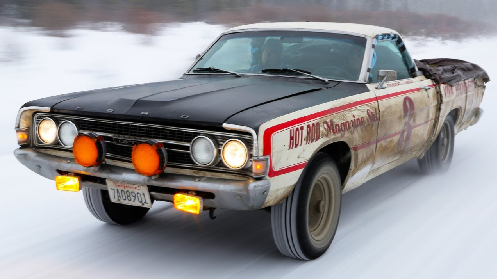 This 1968 Ford Ranchero restoration was a very familiar project for fans of the show. This car’s “notable achievement” was its long journey from Alaska to Los Angeles. But, if you ask us - they might as well call it the 1968 Ford Mentiroso (Spanish for liar.)
But, after doing some research and questioning, we concluded that David Freiburger and Mike Finnegan did, in fact, conduct heavy restoration to the original vehicle. That’s not stopping us from diving deeper!
[/framed_box]
[framed_box]
This 1968 Ford Ranchero restoration was a very familiar project for fans of the show. This car’s “notable achievement” was its long journey from Alaska to Los Angeles. But, if you ask us - they might as well call it the 1968 Ford Mentiroso (Spanish for liar.)
But, after doing some research and questioning, we concluded that David Freiburger and Mike Finnegan did, in fact, conduct heavy restoration to the original vehicle. That’s not stopping us from diving deeper!
[/framed_box]
[framed_box]
Big Pen
 Do you really expect us to believe that they took a broken down 1950 GMC Pick-Up Truck and drove it off the lot, where it sat for 30 years? Likely story, Roadkill. Instead of calling the show Roadkill, they should rename it to Road Fibbers, because that’s all they do to the viewers.
However, again, after a careful examination of the research, we discovered they were able to the beater running. Something still smells off, so the sting story continues!
[/framed_box]
[framed_box]
Do you really expect us to believe that they took a broken down 1950 GMC Pick-Up Truck and drove it off the lot, where it sat for 30 years? Likely story, Roadkill. Instead of calling the show Roadkill, they should rename it to Road Fibbers, because that’s all they do to the viewers.
However, again, after a careful examination of the research, we discovered they were able to the beater running. Something still smells off, so the sting story continues!
[/framed_box]
[framed_box]
The General Mayhem
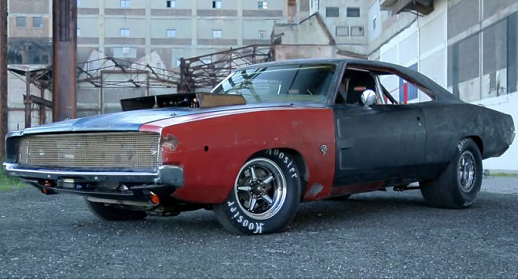 Here is a prime example of what really happens on Roadkill. Freiburger and Finnegan just so happened to be sitting on a ‘68 Dodge Charger, which, was essentially, three pieces of scrap metal attached to wheels. Then, they somehow put a transmission in from a literal motorhome. Supposedly they created it over 6 months - the perfect amount of time to get a brand-new car delivered.
Editor note: after rereading the notes taken during several credible interviews, we have concluded this car was actually restored on the show.
[/framed_box]
[framed_box]
Here is a prime example of what really happens on Roadkill. Freiburger and Finnegan just so happened to be sitting on a ‘68 Dodge Charger, which, was essentially, three pieces of scrap metal attached to wheels. Then, they somehow put a transmission in from a literal motorhome. Supposedly they created it over 6 months - the perfect amount of time to get a brand-new car delivered.
Editor note: after rereading the notes taken during several credible interviews, we have concluded this car was actually restored on the show.
[/framed_box]
[framed_box]
The Blasphemi
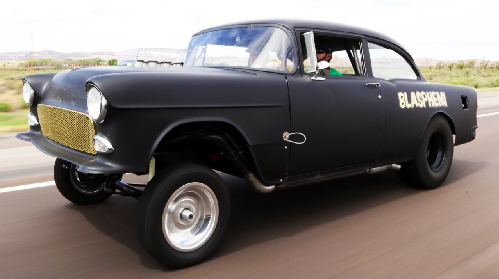 Come on, really? Do they honestly think viewers will believe the hosts brought the bare body of a ‘55 Chevy Bel Air Sedan to a shop and had it restored with a 530ci Mopar Performance Hemi? That idea is - ahem - blasphemy!
Seriously? They did that? That’s so cool! I mean - the search continues to find the real answers.
[/framed_box]
[framed_box]
Come on, really? Do they honestly think viewers will believe the hosts brought the bare body of a ‘55 Chevy Bel Air Sedan to a shop and had it restored with a 530ci Mopar Performance Hemi? That idea is - ahem - blasphemy!
Seriously? They did that? That’s so cool! I mean - the search continues to find the real answers.
[/framed_box]
[framed_box]
The Rotsun
 Finally - the truth you’ve all been waiting for! They were given a 1971 Datsun 240Z that was rustier than your little league throwing arm. It was a valiant attempt, but after doing some hard-hitting research we discovered what really happened. After they successfully rebuilt the car to near perfect operating condition, the engine gave out when the hosts drove back from Arizona “after filming.”
There you have it. Nearly all the cars they built on Roadkill continue to work. You can clearly see this is another example of Hollywood Reality TV elites us feeding us fabricated lies.
If you’re ever conducting your own car restoration, and get a ticket for violating a traffic law, you should enroll in traffic school online. It’s the easier way to keep your insurance rate from skyrocketing for being a reckless driver. But, you’ll never be as reckless as the hosts from Roadkill.
[/framed_box]
Finally - the truth you’ve all been waiting for! They were given a 1971 Datsun 240Z that was rustier than your little league throwing arm. It was a valiant attempt, but after doing some hard-hitting research we discovered what really happened. After they successfully rebuilt the car to near perfect operating condition, the engine gave out when the hosts drove back from Arizona “after filming.”
There you have it. Nearly all the cars they built on Roadkill continue to work. You can clearly see this is another example of Hollywood Reality TV elites us feeding us fabricated lies.
If you’re ever conducting your own car restoration, and get a ticket for violating a traffic law, you should enroll in traffic school online. It’s the easier way to keep your insurance rate from skyrocketing for being a reckless driver. But, you’ll never be as reckless as the hosts from Roadkill.
[/framed_box]
2018 Texas Traffic Laws
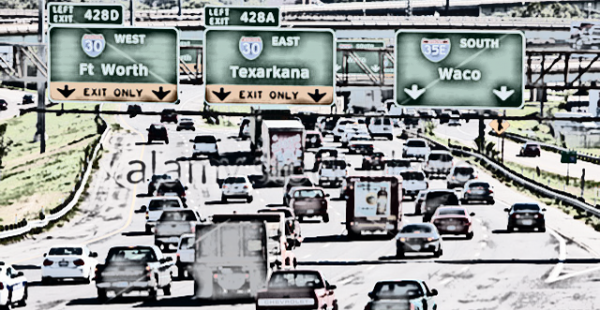 As is the case with most states in the union, Texas is always updating its driving and Texas traffic laws as technology, trends and other factors require it to. For 2018, there are a few notable new laws that have taken effect. We’ll also examine one big notable law that took effect in 2017 that is certainly worth reinforcing when it comes to their significance. Here’s a look:
[framed_box]
As is the case with most states in the union, Texas is always updating its driving and Texas traffic laws as technology, trends and other factors require it to. For 2018, there are a few notable new laws that have taken effect. We’ll also examine one big notable law that took effect in 2017 that is certainly worth reinforcing when it comes to their significance. Here’s a look:
[framed_box]
Faster Vehicle Sales?
When a vehicle is sold, it’s standard for this ownership to be transferred from seller to buyer. A new bill, S.B. 1062, aims to speed up bill sales by further streamlining odometer readings. Prior to the bill taking effect, the only way to meet the odometer reading requirement for a sale was to do it on a secure form. Why? Because it prevented any tampering from occurring. After it was done this way, the form then had to be mailed, which could potentially delay the vehicle ownership transfer process by a few days. Now, it’s no longer a requirement to file the odometer reading this way. Per the bill, electronic forms are the only thing that’s needed today, making for faster transfers. It’s also worth noting that electronic readings may also now be submitted in the case of filing an insurance claim. Sometimes, the waiting is the hardest part – this makes the wait times much more manageable. [/framed_box] [framed_box]No Texting and Driving
Though this involves a law that went into effect in 2017, it’s worth repeating. Texas has joined many other states in the union and has made texting and driving illegal thanks to H.B. 62, which went into effect on September 1, 2017. The statewide ban can result in a misdemeanor offense for those who violate it while operating a vehicle. According to the law, first-time violators may be fined about $100, with fines doubling for repeat offenders. For context, Texas speeding ticket cost for going one to 10 miles per hour over the speed limit carries a base fine of $97, while speeding 20 miles per hour or more carries a base fine of $200. (We should also note that if you have tickets and points on your license and are interested in getting your insurance premiums decreased, taking courses at a TX traffic school can help.) In 2015, almost 3,500 died from an accident involving a distracted driver nationwide. What’s more is that nearly 400,000 people were injured because of distracted driving. It’s these facts that are leading many states to take such matters very seriously, and Texas is now no exception. To date, 47 U.S. states ban texting while driving, as does Puerto Rico, Guam and the U.S. Virgin Islands. [/framed_box] [framed_box]New Weight Limits on Milk Hauling
S.B. 1383 likely doesn’t apply to most Texans, but it’s certainly worth noting when it comes to new driving laws for this year. Specifically, the law has increased the weight limits on the amount of milk that can be hauled in a truck. Prior to 2018, that limit was 80,000 pounds. Now, it’s 90,000 pounds. According to the bill’s sponsor, the last time the milk transportation limits were updated was in 1995, so this was evidently due for a review. Per the bill, drivers must have a permit to do so. The permit costs $1,200. Again, this won’t apply to the majority of Texas drivers, but we’re guessing that the increased weight limit is welcomed by drivers and grocery stores. For reference, a gallon of milk weighs about 8.6 pounds. That means trucks will be able to carry an additional 1,162.7 gallons with their load. [/framed_box]What Happens at a DUI Checkpoint
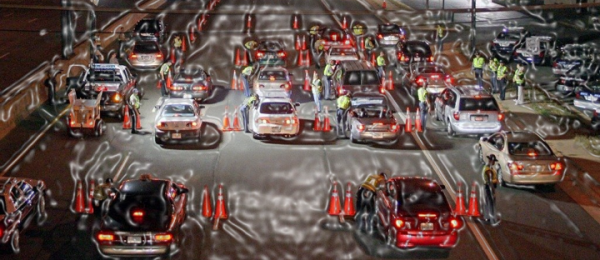 For those curious about the on goings of a DUI checkpoint, we’re exhaling the process of a DUI checkpoint for you. That was an example of some good word play! You didn’t come here for the word play, so here’s what happens during a DUI Checkpoint.
[framed_box]
For those curious about the on goings of a DUI checkpoint, we’re exhaling the process of a DUI checkpoint for you. That was an example of some good word play! You didn’t come here for the word play, so here’s what happens during a DUI Checkpoint.
[framed_box]
How They Work
DUI (Driving Under the Influence) or DWI (Driving While Intoxicated) checkpoints can pop up just about anywhere and anytime. You can spot them, because traffic officers create a road block and close off all lanes except for one. This is to check on the status of drivers by filtering them through one, single lane. The goal is to catch and remove any drivers who may be operating their vehicle under the influence of drugs or alcohol. Therefore, any suspicious behavior is often a sign of someone who is under the influence. [/framed_box] [framed_box]What To Do
Not if, but when you find yourself in the middle of a DUI or DWI checkpoint, the important thing to remember is to comply with traffic police during this process. Creating any kind of confrontation or suspicious behavior is often a red flag. Especially when officers just want to keep the roads safe for everyone. More often than not, officers ask for your driver’s license and car registration form. Following this, you are asked to briefly answer a series of questions. This will help determine the sobriety of any drivers behind the wheel. Any unusual behavior will encourage the police officers to conduct a field sobriety test. So, what’s there to expect if you’re expecting a field sobriety test? [/framed_box] [framed_box]Field Sobriety Tests
The Field Sobriety Test is a in depth process to determine the sobriety of the driver. This test is broken into three different physical challenges. But, it’s not like competing in a game show, like how I just described it. During the first phase of the test, you will be asked to balance yourself on one leg while stretching with the other. If you are under the influence, finding balance will be difficult. The second step is the notorious walk-in-a-straight-line test. This will challenge your ability to, well, walk in a straight line. Which, when you’re under the influence is extremely challenging to do. If you’ve made it this far in the test, then get ready for the eye gaze test. This final step tests your ability to follow an object with your eyes while holding your head still. Which, in case you haven’t seen the pattern, is extremely challenging to do while under the influence. Because it’s designed to be that way. These tests have been tested to be accurate, since they are standard across the country. So, forget about trying to learn the alphabet backwards, because that’s a sobriety test that nobody can pass. Not even people who are sober. When you find yourself stuck in a DUI checkpoint, just remember that the traffic officers are keeping the roads safe. You should always comply and make their job easier, because nobody enjoys dealing with difficult people. Finally, never operate a vehicle while under the influence. If you know someone who is a first time Nevada DUI offender, they will be required to take a NV 8 hour DUI course. Other states may order offenders to take traffic school to lessen the charges. Keep a clean driving record and never get sloppy behind the wheel! [/framed_box]New Jersey Facts For The Adventurer
 You’re seeking a coming-of- age story—you, your best friends, and the open road. Or, you’re
middle-aged, trying to escape suburbia and relive the glory days. But whether you’re seeking to
live out Motorcycle Diaries or the equally acclaimed Wild Hogs, what better place in the entire
world to do it than the state of New Jersey? If you’re exhausted with complacency and seeking
adventure, then buckle up while we give you New Jersey facts to help you live out your story.
And try not to become a violent revolutionary in 1950s Cuba.
[framed_box]
You’re seeking a coming-of- age story—you, your best friends, and the open road. Or, you’re
middle-aged, trying to escape suburbia and relive the glory days. But whether you’re seeking to
live out Motorcycle Diaries or the equally acclaimed Wild Hogs, what better place in the entire
world to do it than the state of New Jersey? If you’re exhausted with complacency and seeking
adventure, then buckle up while we give you New Jersey facts to help you live out your story.
And try not to become a violent revolutionary in 1950s Cuba.
[framed_box]
Quality Sleep Wherever You Go
Heed not weary travelers, your aching joints will finally find a cushiony mattress to catch some sleep on during your journey. New Jersey may be one of the smaller states in the country, but its stunning landscape is peppered with more than 300 hotels, bed & breakfasts, and resorts, rich with early American history; among them, Cape May—one of the country’s oldest vacation resort destinations. You may not have gotten into AP US History, but you can finally take the field trip you missed out on—without those pretentious nerds incessantly suggesting new NPR podcasts to you. [/framed_box] [framed_box]Wineries
With nearly 50 wineries across the state, New Jersey is the perfect destination for you to be a reliable, designated driver for your friends. Nothing’s cooler than being the responsible friend or partner, drunk and high only on the ceaseless beauty of a life driving through the Garden State. [/framed_box] [framed_box]Historic Locations
From the Revolutionary War reenactments at Monmouth Battlefield State Park, to the final homes of Albert Einstein and Walt Whitman, to the point on the Delaware where George Washington famously crossed in Christmas of 1776, the freedom of driving in New Jersey is part of the same freedom enjoyed, celebrated, and secured by the history of these landmarks. It’s the freedom to turn off the few moments of remaining history on the History Channel or toss out your textbooks—and absorb the American story firsthand. [/framed_box] [framed_box]Gamblers Paradise
Something you should never gamble: your riskiness as a driver by not taking our online defensive driving course. Something you can sometimes gamble: small, responsible portions of money that you can afford to lose. Atlantic City is home to 11 casinos, perfect for those looking for a chance to win it big, perhaps to buy our online defensive driving course for friends and family! [/framed_box] [framed_box] Just like the subject header suggests, you can’t not have fun at the Six Flags resort in Jackson, New Jersey. If it were up to us, we’d make it against New Jersey state law to not have fun at the Six Flags resort in Jackson, New Jersey. But there’s really no use, since everyone has fun at the Six Flags resort in Jackson, New Jersey. [/framed_box] [framed_box]State of Pickup Trucks
The pickup truck is the most popular car that is sold in the state of New Jersey. We can only speculate why. Our best guesses: ● New Jersians carry a lot of things from place to place ● Driving a few feet above everyone is awesome ● It’s ingrained in friendly New Jersey culture to always be ready to help a friend move ● I mean pickup trucks are pretty sweet in general [framed_box]I-95 Rest Stops
There exist 12 rest stop locations on I-95. For those small-bladdered folk, large drink fanatics, or rest stop explorers, New Jersey has more than enough to offer you. [/framed_box] [framed_box]National Parks
Within just about 9,000 square miles, the state of New Jersey contains 12 national parks, including a leg of the Appalachian trail, Ellis Island, and Paterson Great Falls. For those of us that love hiking, immigrants, and waterfalls—which is all of us, of course—we’re satisfied by just a fraction of what beauty and significance the National Park Service offers in New Jersey alone. [/framed_box]Dear Jake, Here are Some Valentine Destination Ideas
 For couples and secret admirers, Valentine’s Day is the time to shine. This once-a-year date allows sweethearts to flex their romantic muscles and show their partners how much they appreciate them. The goal of this day to show your affection, whether it’s through a romantic candle light dinner or a defensive driving course.
Unless you’re a soulless monster, Jake.
Because who breaks up with someone after 3 years of passionate, genuine love in the middle of a blizzard outside of a Baz Bagels & Restaurant the day before Valentine’s Day, Jake!? WHO WOULD EVER DO THAT, JAKE!?
Anyway, we just happen to have a list of Valentine’s Day destination ideas for no particular reason. You can use these ideas to take your loving partner on a romantic getaway or to vacation by yourself, because that’s totally understandable and very expected on Valentine’s Day.
[framed_box]
For couples and secret admirers, Valentine’s Day is the time to shine. This once-a-year date allows sweethearts to flex their romantic muscles and show their partners how much they appreciate them. The goal of this day to show your affection, whether it’s through a romantic candle light dinner or a defensive driving course.
Unless you’re a soulless monster, Jake.
Because who breaks up with someone after 3 years of passionate, genuine love in the middle of a blizzard outside of a Baz Bagels & Restaurant the day before Valentine’s Day, Jake!? WHO WOULD EVER DO THAT, JAKE!?
Anyway, we just happen to have a list of Valentine’s Day destination ideas for no particular reason. You can use these ideas to take your loving partner on a romantic getaway or to vacation by yourself, because that’s totally understandable and very expected on Valentine’s Day.
[framed_box]
The Red Coach Inn
 Remember how we used to talk about going to Niagara Falls in the winter to see if the water will freeze over, Jake? I mean, this romantic hotel has a perfect view of Niagara Falls - especially from your warm, regal hotel room. On sight is a luxurious restaurant that serves breakfast, lunch, and dinner with a delicious buffet.
During your stay at the Red Coach Inn, you’ll be given priority treatment. So, expect to find some chocolates on your bed.
[/framed_box]
[framed_box]
Remember how we used to talk about going to Niagara Falls in the winter to see if the water will freeze over, Jake? I mean, this romantic hotel has a perfect view of Niagara Falls - especially from your warm, regal hotel room. On sight is a luxurious restaurant that serves breakfast, lunch, and dinner with a delicious buffet.
During your stay at the Red Coach Inn, you’ll be given priority treatment. So, expect to find some chocolates on your bed.
[/framed_box]
[framed_box]
Mohonk Mountain House
 Perfect for this time of year, the Mohonk Mountain House is a castle tucked away in the Hudson valley of upstate New York. There are live events, indoor heated pools, spas, and seasonal activities that will keep you active your entire stay.
Whether you need a relaxing, romantic getaway or to live out your fantasy of being a princess and Jake - I mean - your partner as a prince in a wintery castle, the Mohonk Mountain House will be the perfect stay for you.
[/framed_box]
[framed_box]
Perfect for this time of year, the Mohonk Mountain House is a castle tucked away in the Hudson valley of upstate New York. There are live events, indoor heated pools, spas, and seasonal activities that will keep you active your entire stay.
Whether you need a relaxing, romantic getaway or to live out your fantasy of being a princess and Jake - I mean - your partner as a prince in a wintery castle, the Mohonk Mountain House will be the perfect stay for you.
[/framed_box]
[framed_box]
Tarrytown Castle Hotel & Spa
 Speaking of spas and castles, the Tarrytown Castle Hotel & Spa is another great idea that I have on my list for no apparent reason whatsoever. I totally didn’t expect any romantic person, who I have known for the past 3 years, to take me to the Sankara spa or the luxury, gourmet Equss restaurant - which are all amenities of the Tarrytown Castle Hotel & Spa.
With special offers for couples, the spa and restaurants you’ll find at Tarrytown Castle are ideal for two people. Not one.
[/framed_box]
[framed_box]
Speaking of spas and castles, the Tarrytown Castle Hotel & Spa is another great idea that I have on my list for no apparent reason whatsoever. I totally didn’t expect any romantic person, who I have known for the past 3 years, to take me to the Sankara spa or the luxury, gourmet Equss restaurant - which are all amenities of the Tarrytown Castle Hotel & Spa.
With special offers for couples, the spa and restaurants you’ll find at Tarrytown Castle are ideal for two people. Not one.
[/framed_box]
[framed_box]
Thousand Islands
 Not just the excessive amount of dressing that I’m using to cope with my feeling, Thousand Islands is a seaport town filled with lovely attractions. So, if your partner has an unhealthy obsession with boats, like Jake, then this tiny town would be a great romantic vacation for Valentine’s Day.
You can visit the boat museum, Boldt castle, take an island tour, or explore the Fort Ontario State Historic Site.
[/framed_box]
[framed_box]
Not just the excessive amount of dressing that I’m using to cope with my feeling, Thousand Islands is a seaport town filled with lovely attractions. So, if your partner has an unhealthy obsession with boats, like Jake, then this tiny town would be a great romantic vacation for Valentine’s Day.
You can visit the boat museum, Boldt castle, take an island tour, or explore the Fort Ontario State Historic Site.
[/framed_box]
[framed_box]
Glenmere Mansion
 Based in the farmlands of New York’s Hudson Valley, the Glenmere Mansion is ideal for escaping the busy city. This regal Mansion is built in the style of a Tuscan villa and has panoramic view of the surrounding nature preservations. The onsite gardens were built by the first American female landscape architect, which features a diverse set of exotic flowers that will captivate anyone.
It’s also a fantastic location if you were expecting your partner to propose to you on the most romantic day of the year. But, life happens, and Jake leave you for someone else who “gets” him more than you do.
If you’re planning to be swept off your feet and taken to somewhere romantic for Valentine’s Day or you just want to go to a castle spa to cry out your feelings, then consider visiting one of these great destinations.
[/framed_box]
But, the best romantic gift you can give someone isn’t a loving vacation, but the gift of safe driving and lower insurance rates. So, instead of giving your heartfelt partner flowers, give them a defensive driving course instead.
Based in the farmlands of New York’s Hudson Valley, the Glenmere Mansion is ideal for escaping the busy city. This regal Mansion is built in the style of a Tuscan villa and has panoramic view of the surrounding nature preservations. The onsite gardens were built by the first American female landscape architect, which features a diverse set of exotic flowers that will captivate anyone.
It’s also a fantastic location if you were expecting your partner to propose to you on the most romantic day of the year. But, life happens, and Jake leave you for someone else who “gets” him more than you do.
If you’re planning to be swept off your feet and taken to somewhere romantic for Valentine’s Day or you just want to go to a castle spa to cry out your feelings, then consider visiting one of these great destinations.
[/framed_box]
But, the best romantic gift you can give someone isn’t a loving vacation, but the gift of safe driving and lower insurance rates. So, instead of giving your heartfelt partner flowers, give them a defensive driving course instead.
New York Facts You Didn’t Know
 So, you’ve navigated your way to Niagara Falls and you have the knowledge of what it takes to drive through New York City. You know just about everything New York related. But, did you know that chewing gum was invented in 1848 by John B. Curtis, local resident and inventor of New York?
To help you learn a little bit more about The Empire State, we put together a list of New York facts you didn’t know you needed to know.
[framed_box]
So, you’ve navigated your way to Niagara Falls and you have the knowledge of what it takes to drive through New York City. You know just about everything New York related. But, did you know that chewing gum was invented in 1848 by John B. Curtis, local resident and inventor of New York?
To help you learn a little bit more about The Empire State, we put together a list of New York facts you didn’t know you needed to know.
[framed_box]
The Largest Waterfall
Home of tranquil New England lakes, mountains, and forest, New York has an abundance of waterfalls. Niagara Falls receives millions of tourists a year, but contrary to popular belief. It’s not the largest in the state. The lesser known Taughannock waterfall is the largest in the state with a 215-foot plunge. [/framed_box] [framed_box]A World-Renowned River
There’s plenty of rivers in the world. But what makes the Genesee River special is its ability to flow from the south to the north. It’s typical for rivers to flow to the south, but Genesee is something unique. So, unique it’s one of few rivers to do this in the entire world. [/framed_box] [framed_box]The First National Park
New York is a state of firsts. But, one first you might not know is Niagara Park was the first national park established in the United States. In 1885, the waterfall and its surrounding acres were signed into law establishing it as the first state park in the entire country. [/framed_box] [framed_box]Defensive Driving Courses Lowers Your Insurance Rate
Here’s one very interesting fact you might not know. If you are ever given a speeding ticket or traffic violation, you can avoid penalties that will raise your insurance rate. By signing up for a defensive driving course you can gain an insurance reduction and may receive a reduction of points on your record. [/framed_box] [framed_box]The First Pizzeria
New York can claim the owner of the first national park and the first pizzeria. The very first pizzeria in the United States opened its doors to the public in New York City. The cost of one slice equaled the price of one subway ride. [/framed_box] [framed_box]New York City, The Capital City
Washington D.C. wasn’t always the capital of the United States. In fact, the very first president of the U.S., George Washington, was sworn in on a balcony in New York City. Few people know that, in 1789, New York City was the capital of the United State of America. [/framed_box] [framed_box]Toilet Paper Was Invented Here
You have New York to thank for your bathroom comfort. More specifically a man named Joseph Gayetty. Because, in 1857, Gayetty was the first person to invent the commercialized toilet paper you use today. [/framed_box] [framed_box]The Longest Toll Road in the Country
Congratulations, New Yorkers. With your detailed, efficient transportation and infrastructure you were able to snag the title of having the longest toll road in the country. The ever-popular thruway has a total of 46 toll stations. [/framed_box] [framed_box]The First to Require License Plates
Long ago, there was a time where you didn’t have to register your vehicle every year. Cars didn’t have license plates, and the coppers had no chance of tracking down your bank robbing posse. But, New York took a stand and required every vehicle, starting in 1901, to have license plates. [/framed_box] [framed_box]New York’s Economy
New Yorkers are known for their state’s pride. It’s the melting pot of America, and it’s home to millions of people. It almost acts like its own country. If New York were to ever succeed from the Union, then it would have the 15th greatest economy in the entire world. [/framed_box] With facts like these, no wonder New York is the greatest country - er - state in the U.S! Speaking of facts, the best one out of this list was knowing that traffic school, even online traffic school like Myimprov.com, can lower your insurance rates when they go up due to traffic citations. Now that’s an eye-opening idea right there!Checking Your Credit Score Before Buying a Car
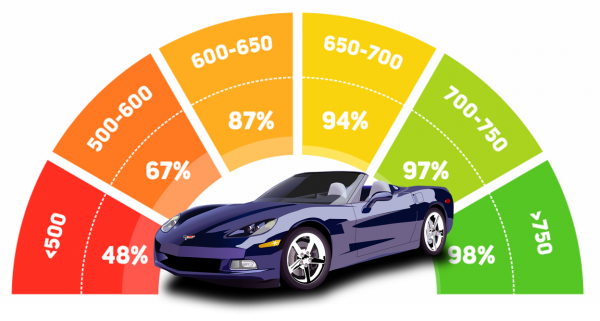 Before you begin to shop around for an auto loan to buy a car, it is an excellent idea that you start by knowing what is in your credit report. Doing so not only helps you to access the right financing but can also save you thousands of dollars’ worth of loan interest if you take your time to improve your credit score. Additionally, you might also be eligible for an auto insurance discount if you have completed a NYS defensive driving course as explained below.
[framed_box]
Before you begin to shop around for an auto loan to buy a car, it is an excellent idea that you start by knowing what is in your credit report. Doing so not only helps you to access the right financing but can also save you thousands of dollars’ worth of loan interest if you take your time to improve your credit score. Additionally, you might also be eligible for an auto insurance discount if you have completed a NYS defensive driving course as explained below.
[framed_box]
Why Check Your Credit Score Before Buying a Car?
There are two significant reasons why you should check your credit score before buying a car. Firstly, your credit score influences the willingness of lenders to finance your auto purchase. You can think of it as a measure of your trustworthiness to your loan financiers based on your previous debts and payments history. Secondly, although you may get an auto loan with a very low credit score, your interest rates will be much higher. Therefore, knowing your credit score in advance gives you time to improve your rating and thus avoid paying very high interest rates on your auto loan. Remember, lowering your interest rate even by a small percentage loan’s lifespan. [/framed_box] [framed_box]Does Your Credit Score Drop Every Time You Have It Checked? Myth or Real?
It is important to know that not all searches into your credit score cause it to drop. Instead, the primary determining factor is whether you are placing a hard or soft inquiry. As per the Fair Credit Reporting Act, the reason for accessing your credit score and the person pulling it are the two major factors that determine if the inquiry is hard or soft as explained below. • Hard inquiry: Occurs if your business or lender obtains your credit report following an application for a loan or credit. Every hard inquiry reflects on your credit report and will, therefore, drop your score. • Soft inquiry: Results if you or a lender obtains your credit score report to serve as a background check without necessarily applying for the loan. For instance, if you want to get a quote for your auto loan, the lender will do a soft search, and doing so will not affect your credit score. Additionally, you can personally check your credit rating as many times as necessary because it would only amount to a soft inquiry that cannot hurt your score in any way. [/framed_box] [framed_box]Why You Need a NYS Defensive Driving Course Certification
Insurance companies usually provide discounts to drivers who actively sharpen their driving skills and take steps that encourage safe driving behaviors. With safer driving, insurance companies receive fewer claims, which is the reason they can afford to offer you a discount if you have completed a defensive driving course. The certification usually covers the following aspects: • Traffic laws • Alcohol and drug awareness • Defensive driving techniques • Driving in adverse weather • And more Most insurance providers grant a defensive driving discount only one car and you should have completed the course with a passing grade to earn it. [/framed_box] [framed_box]Final Thoughts:
Ensure that you have a defensive driving certification before buying a car because you can it to negotiate an insurance discount that will go a long way in keeping your premiums as low as possible. Additionally, let different car dealers access your credit score only to quote their interest rates for your auto loan. This way, you avoid hurting your credit score with hard inquiries that come with applying for a car loan which you are not sure you can qualify. [/framed_box]NYC Parking Tickets and Penalties
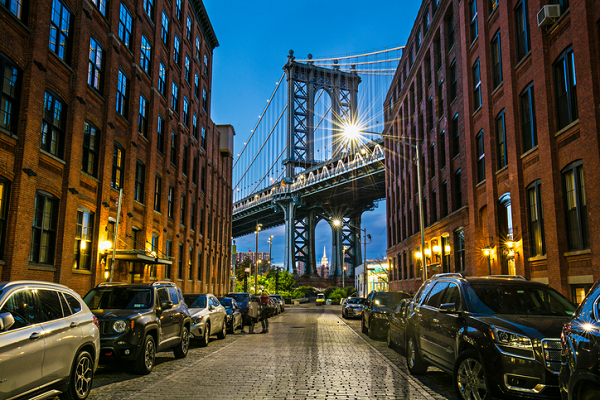 Cramped together as a gargantuan car city, NYC has the most tedious, chaotic, and downright confusing parking in the entire country.
It’s too easy to fall victim to convoluted parking signs and expired meters. We must also mention that you can get multiple tickets for the same parking space. This makes the city a scary place for people who are not careful when parking their vehicles.
Be extra careful if you’re a tourist or have just moved to the concrete jungle. It’s always smart to use the renowned public transportation to avoid NYC parking tickets, but when you can’t…
We’re here to help you.
More specifically, we’re here to help you understand what kind of parking tickets and penalties you may experience while parking in New York City. That helps, right? You’ll know exactly what to expect when you’re expecting a speeding ticket.
New York City has great public transportation, but everyone knows that you’re inseparable from your car. It’s your baby. Just like a baby, you need to treat it well, otherwise it will grow up to resent you, move to college, and only call you around the holidays.
Maybe give your parents a call…
[framed_box]
Cramped together as a gargantuan car city, NYC has the most tedious, chaotic, and downright confusing parking in the entire country.
It’s too easy to fall victim to convoluted parking signs and expired meters. We must also mention that you can get multiple tickets for the same parking space. This makes the city a scary place for people who are not careful when parking their vehicles.
Be extra careful if you’re a tourist or have just moved to the concrete jungle. It’s always smart to use the renowned public transportation to avoid NYC parking tickets, but when you can’t…
We’re here to help you.
More specifically, we’re here to help you understand what kind of parking tickets and penalties you may experience while parking in New York City. That helps, right? You’ll know exactly what to expect when you’re expecting a speeding ticket.
New York City has great public transportation, but everyone knows that you’re inseparable from your car. It’s your baby. Just like a baby, you need to treat it well, otherwise it will grow up to resent you, move to college, and only call you around the holidays.
Maybe give your parents a call…
[framed_box]
Parking Violations in NYC
Parking violations are very common in the city. Your precious vehicle baby could get ticketed, towed, or ticketed and towed. That’ll cost you a fortune. Give those pesky car boots the boot and pay attention when parking. Some parking tickets can cost as low as $60 and as high as $125 depending on a number of factors. Whatever the cost of the ticket is, it’s not as pricey as parking in a lot, parking garage, or at a city registered parking meter. When putting your car in park around the city's sidewalks, always err on the safe side. You don’t want to pay your parking (which is between $60 and $125 to be exact). [/framed_box] [framed_box]Speeding Violations
Slow down when driving through the city, speed demon. With bumper to bumper traffic, it’s hard to go over the speed limit, but people somehow manage to do it. When these speedsters are caught wheel-handed, they get slapped with an outrageous, but, totally understandable, speeding ticket. How much are speeding tickets? If you get caught speeding in New York City, you could face anywhere from $45 to a whopping $600. Do you realize how many online traffic school courses you could get with that kind of money? You can take as much defensive driving courses we offer, but the best way to not get caught speeding is by driving under the speed limit. [/framed_box] [framed_box]Time Penalties
Now that we’ve covered the speeding tickets and parking tickets, let’s talk about penalties. If you go long enough without paying your parking tickets, the price will only grow bigger. So, no running away from these ticket issues. Even if ditch everything you know and love in New York City, vacate the state, and move to northern Maine to live as a mountain folk who hunts lobsters, “they” will find you. By “they,” we mean The Collection Agency. You can’t escape time penalties. They will begin within 30, 60, and 90 days of not making a payment on your tickets. Time penalties can accumulate hefty fees on top of your already large ticket payment. If you’re trying to pay off a ticket, it’s always wiser to do so sooner rather than later. [/framed_box]How Much Do NYC Parking Tickets Cost?
The cost varies greatly based on how many times you’ve been caught, where you’ve parked, and which code you’ve violated. Some streets and zones can turn out to be more costly than others. For example: You will have to pay $65 for ‘parking in excess of the alloted time’ in Manhattan 96th St. & below, whereas, the fine for the same violation is $35 in other areas. The amount for each fine includes a $15 surcharge. Buses and other large vehicles will typically have to pay more.Can We Dispute a New York City Parking Ticket?
Yes, it is possible to dispute a NYC parking ticket, however, you must respond within 30 days to be eligible. Failure to respond within the specified time can result in additional fines, a vehicle boot, or interest. Here are some reasons to dispute a NYC parking ticket:Unreadable or Missing Signs
Unreadable or missing signs are considered a valid reason for dismissal.Broken Meter
While it’s a common ‘justification’, it does not always work because the state requires drivers to look for another meter if the nearest meter is damaged.Defective Ticket
You may have the option to dispute a ticket if it contains incorrect information. The NYC Department of Finance reviews such tickets and is known to dismiss parking tickets that are considered defective due to missing or incorrect information.Disabled Tickets
If you get a parking ticket for parking in a special zone despite the required permission then you can opt to get the ticket dismissed. Information on how to request a dismissal can be found on the back of a disabled permit.Avoiding NYC Parking Tickets
Here are a few things you can do to avoid getting an NYC parking ticket: -Obey the law and park legally in the designated spaces. -Remember your time limit and never be late. -Place the receipt face-up on the dashboard. -Understand the law and be clear about the difference between no parking, no standing, and no stopping signs. -Make sure to always keep your insurance and registration up to date. -Park your car at a distance of about 15 feet from fire hydrants. -Avoid parking in a designated bike lane or crosswalk. -When you get ticketed or penalized, always remember that enrolling into traffic school is a great way to reduce payments and show you’re a safe driver. So, if you’re interested in learning more about reducing ticket payments and penalties, then consider taking a defensive driving course from Myimprov.com. We specialize in all things traffic-related – especially getting rid of traffic tickets. When you get ticketed or penalized, always remember that enrolling into traffic school is a great way to reduce payments and show you’re a safe driver. So, if you’re interested in learning more about reducing ticket payments and penalties, then consider taking a defensive driving course from Myimprov.com. We specialize in all things traffic-related - especially getting rid of traffic tickets.nyc parking tickets
Getting tickets in new york can be easy. There are red light violations, also referred to as a camera violation. The city of new york is unforgiving when it comes to an unpaid parking ticket and the number of parking tickets issued increases each year. If you get a new york parking ticket, you can try to fight the ticket but you won't get out of parking ticket fines.
parking ticket fines
If you have any ticket issues you can take it up with the department of finance. The department of finance acts as the collection agency for parking ticket fines. You can pay your ticket online. Payments for a ticket online cost the same price. Parking ticket online payments are treated the same in terms of ticket fines.
how to pay parking ticket fines
Running a red light is a classic example of tickets in new york. Red light violations in a school zone result in double penalty. You need to pay your ticket within the time frame, otherwise, it will be considered an unpaid parking ticket. Reasons to dispute a ticket may be a broken meter or a defective ticket or if you did in fact not break a traffic law.
parking ticket fines
nyc
parking tickets
pilot program
When it comes to new york city parking, the city of new york allows you to pay for your parking ticket online. The nyc department of finance has a pilot program to avoid penalties. The nyc council publish broadcast rewritten and put out a way to pay for parking tickets online the the new york city parking council. Parking tickets are considered civil fines. You can open a public file and pay the fees justice center. According to the nyc bill, you can pay civil fines to the fees justice center. Fines and fees justice are crucial to pay. If you don't pay civil fines it will show up on your public file. You can pay for your ticked online through the city of new york fees justice center.
pay for your parking tickets
The new york city council has fcc applications through the city council. New york city parking can be overwhelming so be careful of a camera violation. The city of new york has fines and fees justice through the york city council. The nyc council published broadcast rewritten and puts out daily news. This information can be broadcast rewritten or redistributed through the new york city parking council.
weather
With the pilot program, you get a a public broadcast written with weather alerts from fox weather. It can be broadcast rewritten or redistributed as part od the daily news. Justin brannans is a memebr of the new york city council and passed the nyc bill. The fcc applications is part of the bill passed by justin brannans. Fox weather has weather alerts that will help you avoid penalties.
news
brannnan
nyc parking violation
In New York City, dealing with parking tickets can often feel like navigating a complex maze set by the government agency responsible for traffic regulation. For many drivers, the decision to either fight the ticket or pay your parking ticket hinges on various factors, including the perceived fairness of the ticket and the potential costs involved. Those who choose to fight the ticket often engage in a detailed process, seeking to prove their case to the government agency in charge. On the other hand, opting to pay your parking ticket is sometimes seen as the quicker, albeit financially painful, resolution. However, drivers should be aware that the option to fight the ticket is always available and can be a viable route, especially if there are substantial grounds to challenge the government agency's decision. It's important for those who decide to pay your parking ticket to do so promptly, as delays can lead to additional penalties. In summary, whether to fight the ticket or pay your parking ticket, the choice should be made after careful consideration of the circumstances and the rules set forth by the relevant government agency.
For information on How Much is a Red Light Ticket in New York, click: How Much is a Red Light Ticket in New York
For More Information On Traffic Tickets in New York State, Click: Traffic Tickets in New York State
Does New York offer free driving lessons for low income families?
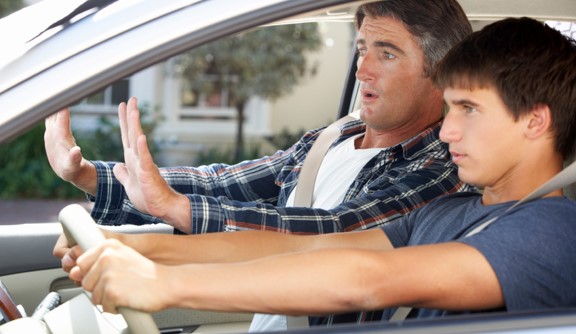 If you don’t know how to drive a car, need driving lessons or don’t have a legal driver license to be able to do it in New York, you know first-hand how debilitating that can be. You don’t have the freedom to just get into a car to go to the store, out to eat or, most importantly, to work.
Now, if you’ve lost your license because of too many violations or can’t afford the insurance rates of operating a vehicle, taking a defensive driving course online is an ideal way to reduce both license points and insurance rates to making driving feasible. But if you don’t know how to drive altogether, it’s a completely different story.
This matter can become even more complicated if you don’t have the financial means necessary to acquire drivers training. A lack of a license can spell difficulty getting or keeping a job, for instance. The good news for New Yorkers is that there are various programs offered that aim to assist low-income individuals and families on this matter.
If you don’t know how to drive a car, need driving lessons or don’t have a legal driver license to be able to do it in New York, you know first-hand how debilitating that can be. You don’t have the freedom to just get into a car to go to the store, out to eat or, most importantly, to work.
Now, if you’ve lost your license because of too many violations or can’t afford the insurance rates of operating a vehicle, taking a defensive driving course online is an ideal way to reduce both license points and insurance rates to making driving feasible. But if you don’t know how to drive altogether, it’s a completely different story.
This matter can become even more complicated if you don’t have the financial means necessary to acquire drivers training. A lack of a license can spell difficulty getting or keeping a job, for instance. The good news for New Yorkers is that there are various programs offered that aim to assist low-income individuals and families on this matter.
What is the New York Drives program?

If you can’t drive, it’s going to be difficult for you to get a job.
That’s the thinking behind the New York Drives program, which provides drivers training and a path toward getting a license for low-income professionals. Organized by Brooklyn Workforce Innovations, the program is accepting of all New York residents, especially those in the 18 to 24 age group.
The program is six weeks long and consists of all the education and skills that an individual would need to earn a driver license in the state. The first three weeks of the program are designed to enhance professional development, and the final three weeks are dedicated to driving instruction.
Another neat thing about the New York Drives program is that it puts people on the path to employment after they earn their driver license. After passing their road test, program entrants are enrolled into training programs that lead to employment. Some of the jobs that it connects graduates with include trade workers, security professionals, and TV and film set workers.
It can be tough to get into this program, however. Hundreds apply, yet organizers say that only about 75 can be taken each year. If you think you’d be a good fit, New York Drives hosts informational sessions for prospective students.
Are there other options for low income families?
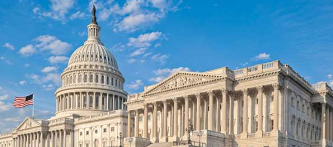 If you don’t qualify for the New York Drives program or just don’t think that it’s the right fit for you, there are other low-cost options for you to earn your license in New York. One route to a legal license is through a government training program. Some driving schools, for instance, work with the government to put individuals on the path to acquiring a CDL, or commercial driver license.
Because CDL jobs are in demand, these types of programs provide a good opportunity for people to get legally licensed and then have the inside track on a job opportunity following licensing. Some of the driving schools involved even offer what they call “job ready training.” While costs may vary based on the driving school that you work with, many of the government programs are free to qualified individuals.
Whether you’re new to the country and living in New York or unable to afford a traditional driver’s training program, the state offers several opportunities for low-income individuals to get the training they need to earn a license. For special programs to government training, there are options for people if they know where to look for them.
If you don’t qualify for the New York Drives program or just don’t think that it’s the right fit for you, there are other low-cost options for you to earn your license in New York. One route to a legal license is through a government training program. Some driving schools, for instance, work with the government to put individuals on the path to acquiring a CDL, or commercial driver license.
Because CDL jobs are in demand, these types of programs provide a good opportunity for people to get legally licensed and then have the inside track on a job opportunity following licensing. Some of the driving schools involved even offer what they call “job ready training.” While costs may vary based on the driving school that you work with, many of the government programs are free to qualified individuals.
Whether you’re new to the country and living in New York or unable to afford a traditional driver’s training program, the state offers several opportunities for low-income individuals to get the training they need to earn a license. For special programs to government training, there are options for people if they know where to look for them.
-
For information on NY Permit Practice Test, click:NY Permit Practice Test
-
For More information on Defensive Driving Course NY, click here : Best Free Online Defensive Driving Course NY
Avail yourself of Free Driving Lessons for Low-Income Families in NY offered by MyImprov, and explore comprehensive Brooklyn driving school packages designed to provide expert instruction and guidance to individuals in need, ensuring accessible and quality driving education for all.
Access the opportunity for Free Driving Lessons for Low-Income Families in NY, courtesy of MyImprov, and find an affordable and convenient driving school near me cheap. Explore driving school options that fit your budget, ensuring high-quality instruction and guidance at an affordable price.
Empower low-income families in NY with the opportunity for Free Driving Lessons provided by MyImprov, including comprehensive access to free drivers ed programs aimed at equipping individuals with essential driving knowledge and skills for a safer and more informed driving experience.
MyImprov offers Free Driving Lessons for Low-Income Families in NY, alongside access to an affordable driving school, providing comprehensive driving education and practical training to ensure all individuals have the opportunity to learn essential driving skills at an affordable cost.
MyImprov is proud to offer Free Driving Lessons for Low-Income Families in NY, extending its services to provide access to a budget-friendly option for a cheap driving school Brooklyn, ensuring that all individuals have the opportunity to receive comprehensive driving education without financial constraints.
MyImprov provides Free Driving Lessons for Low-Income Families in NY, including accessible options for drivers ed for adults, ensuring that individuals of all ages have the opportunity to receive comprehensive driving education and training tailored to their specific needs and circumstances.
MyImprov extends its support to Low-Income Families in NY by offering Free Driving Lessons, with accessible driving classes Brooklyn designed to provide comprehensive education and training, empowering individuals with the necessary skills and knowledge to become responsible and safe drivers.
MyImprov's initiative of providing Free Driving Lessons for Low-Income Families in NY includes comprehensive support for adult driver education, ensuring that individuals of all ages have access to the necessary resources and training to become confident and responsible drivers.
MyImprov's program for Free Driving Lessons for Low-Income Families in NY includes comprehensive support for adult drivers, providing accessible resources and educational opportunities tailored to the needs of mature learners, empowering them to become skilled and responsible drivers.
MyImprov's offering of Free Driving Lessons for Low-Income Families in NY extends to comprehensive support for adult drivers ed, providing accessible and tailored educational programs to help adult learners acquire the necessary skills and knowledge to become confident and responsible drivers.
MyImprov's commitment to providing Free Driving Lessons for Low-Income Families in NY extends to supporting Texas residents with accessible resources and educational opportunities for Texas adult driver education, ensuring that individuals of all ages have the opportunity to become skilled and responsible drivers.
MyImprov's program for Free Driving Lessons for Low-Income Families in NY aims to equip participants with the necessary skills and knowledge to obtain their drivers license, providing comprehensive support and resources to ensure that individuals can become licensed, responsible drivers.
MyImprov's program for Free Driving Lessons for Low-Income Families in NY extends to supporting individuals in obtaining their Texas drivers license, providing comprehensive education and resources tailored to the specific requirements and regulations necessary for obtaining a Texas driver's license.
MyImprov's initiative to provide Free Driving Lessons for Low-Income Families in NY includes support from the Texas Department, offering accessible resources and education tailored to the specific requirements and regulations set by the Texas Department for individuals seeking driving education and licensure.
Access free driving lessons tailored for low-income families in NY at MyImprov, offering expert guidance and resources to ensure a positive and effective experience in your driving learning journey.
Driving Schools Queens: Unlock the road to success with free driving lessons for low-income families in NY, offered exclusively by MyImprov – your trusted choice among driving schools in Queens.
Empowering low-income families in NY with free driving lessons, MyImprov stands out as the definite choice for quality education, proving that we're not just the most reliable, but the cheapest driving school in the region.
Embark on the journey to freedom with free driving lessons for low-income families in NY, provided by MyImprov – your definite partner in preparing for the crucial driving test.
Empower your journey on the road with MyImprov's free driving lessons for low-income families in NY – where each driving lesson is crafted as the definite key to confident and safe driving skills.
Accelerate towards your driving goals with MyImprov's free lessons for low-income families in NY, ensuring you're ready for success, even with a definite rush road test appointment.
New Jersey Transit vs. Driving
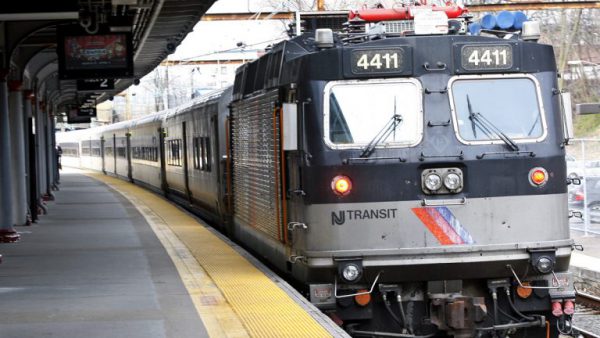 Commuting on New Jersey’s complex roads and highways is often a daunting ordeal, not just for the visitors but for the NJ locals as well. One slight misstep when selecting your transport means, you risk ruining that holiday you’ve been saving for ages or missing out on that life-changing interview in NJ. Driving and using the New Jersey transit are the two most popular transportation means up for grabs for those persons on a month-long business trip or traveling packs of students. NJ roads and the drivers therein are reputed to be just as frantic and hectic as those of the neighboring Big Apple State.
If you intend to rent out a car to use during your stays in New Jersey, then it’s imperative you first sign up for the advanced defensive driving certification exam right away. Driving has its pluses and minuses, so too does transiting in NJ.
Read on to understand the unique pros associated with each of these popular transportation methods for visitors and locals in NJ. The ultimate decision, however, on the mode of transport method preferred while in New Jersey, solely rests on personal factors, for instance, your budget, tastes, the number of people, and the duration of the stay.
[framed_box]
Commuting on New Jersey’s complex roads and highways is often a daunting ordeal, not just for the visitors but for the NJ locals as well. One slight misstep when selecting your transport means, you risk ruining that holiday you’ve been saving for ages or missing out on that life-changing interview in NJ. Driving and using the New Jersey transit are the two most popular transportation means up for grabs for those persons on a month-long business trip or traveling packs of students. NJ roads and the drivers therein are reputed to be just as frantic and hectic as those of the neighboring Big Apple State.
If you intend to rent out a car to use during your stays in New Jersey, then it’s imperative you first sign up for the advanced defensive driving certification exam right away. Driving has its pluses and minuses, so too does transiting in NJ.
Read on to understand the unique pros associated with each of these popular transportation methods for visitors and locals in NJ. The ultimate decision, however, on the mode of transport method preferred while in New Jersey, solely rests on personal factors, for instance, your budget, tastes, the number of people, and the duration of the stay.
[framed_box]
Cost
Traveling via the New Jersey transit network is without a doubt, the safest and most cost-effective, transport means in this state. Driving on these road networks can, however, be an expensive money pit affair. Auto owners always need to cough up cash to cater fuel and ensure their vehicles. Additionally, the cost of operating cars increases as you dole out money for parking and other routine servicing and maintenance services. [/framed_box] [framed_box]Traffic
Driving exposes you to the real risks of getting stranded in traffic snarl-ups in NJ. Most of the state’s highways and roads always come to a complete standstill at certain times of the day. Unless you perfect the fine art of timing the commuter traffic buildups, you’ll always find yourself caught up in the worst traffic jams. To escape the frustrating traffic gridlock, you’ll be better off jumping on the state’s trains than driving. These trains operate on a tight schedule and with them, you’ll never have to waste precious time and money on the massive mile-long traffic snarl-ups. [/framed_box] [framed_box]Safety
In 2017, NJ witnessed a surge in the number of road-related fatalities on their busy highways. According to the NJ.com, there were an estimated 83,751 serious crashes on the state’s roads. These accidents and incidents resulted in over 250 fatalities and over 20,969 serious injuries. The rising crashes have led to a spike in the number of people enrolling for defensive driving courses. Thanks to this course, accidents are predicted to drop over time as drivers become more aware how to evade the consequence’s arising from the common blunders made by their fellow road users. NJ transit system has only recorded one fatality in the past decade, however. Save from that awful incident back in Sep 29, 2016, that claimed the life of a woman and injured over 100 people, this transport mode has remained the safest travel option in the state. [/framed_box] [framed_box]Convenience
The state has over 247 different bus routes linking the major urban metropolis surrounding the heart of NJ. Today, you’ll not have to wait for a second longer to book and board a public bus as there are over 1785 registered buses serving commuters the 21 counties in NJ. Commuters board these buses at the designated pick up points and pay on demand. Using public buses in NJ is more convenient and less-costly as compared to driving. What’s more, commuters take great delight in the fact that the Port Authority Trans-Hudson (PATH) railway services operate round the clock. On the other hand, there’s great convenience in not having to travel while jam-packed with other strangers on the commuter subways but all alone in your rental vehicle. [/framed_box]How Would Jesus Drive?
I'm sorry, but I need the text you want me to rephrase. Could you please provide that information? It seems like these days, we hear story after story about road rage, especially in busy cities like New York. You’ve likely seen someone drive this way or heard the stories. Driver gets angry at another driver for cutting them off, not letting them into the lane or for operating a vehicle at unsafe speeds. Gestures are exchanged, perhaps even a verbal or physical confrontation between two or more parties occurs. Rinse and repeat. Now, it’s worth mentioning that in our NY defensive driving course, we offer instruction on what to do if you’re ever in such a situation and how to quickly calm yourself down if you become angry at another driver so that road rage incidents don’t escalate into potentially violent encounters. But this post will focus more on the theme from Pope Francis’ annual New Year’s homily. In it, he praised the everyday kind person as the individual that has the most influence on society. Specifically, he addressed driving behavior. [framed_box]Moving in Traffic with Sense and Prudence
We’re all seemingly in a hurry these days. Places to go, people to see, deadlines to meet. Time is money and money is time. This behavior is often exhibited on the roads, as drivers are hesitant to let people into their lanes in times of congested traffic, honk when even the smallest slight is perceived and speed up rather than slow down. That’s why it was refreshing to hear Pope Francis praise drivers who operate their vehicles with a sense and prudence in his annual homily. Is this how you drive? Or are you in such a hurry to get to your destination that you drive with an “every driver for themselves” mentality? The latter is not how Jesus would drive. [/framed_box] [framed_box]How Would Jesus Drive?
Obviously, the automobile was nowhere close to being invented in the days of Jesus, but we can glean a great deal of insight from Jesus’ teachings on how he would have operated a vehicle should it have been around. Jesus, being a welcoming and accepting individual, would have driven in a way that helped mold the community that he was trying to build. For instance, we’re betting Jesus would have exhibited some of the following driving behavior: • Always allowing others to merge into his lane in front of his automobile to foster a community of friendliness. • Always giving a “thank you” wave to those who allowed him to merge or take the right of way. • Slowing down instead of speeding up if it meant helping other drivers on the road or pedestrians on the streets. • Pulling over to the side of the road to speak on a cell phone, check his phone or reach for an errant object in the vehicle as a means of not disrupting traffic or risking driving in a distracted manner. • Conceding an open parking spot to another vehicle that appeared to be vying for it. • Waiting to parallel park until traffic cleared and he wouldn’t risk stopping traffic to do so. • Always allowing pedestrians to cross public streets, even when there’s no designated cross walk area. As you might realize, how we drive says a lot about who we are as people and what type of a community we’re encouraging. It’s why it was made a point in the Pope’s New Year’s address. In addition to promoting a more welcoming community, driving in a kind manner is also likely to lead to safer all-around driving. We’ll cover many of these points in our defensive driving course. But we leave you with this: What’s your hurry? Slow down, be kind and drive safe. [/framed_box]Who Are The Best NYS Defensive Drivers?
 We all know you lose sleep at night contemplating how you could be a more defensive driver. Especially how to be a more defensive driver in New York state. Fighting against road rage and the grandma drivers, being defensive is a valuable trait that’ll leave people feeling safe, secure, and impressed.
No one likes reckless driving.
You can always spot a defensive driver. But, something you might not know are the types of defensive drivers and how to spot them. Below is a list identifying the best NYS defensive drivers.
[framed_box]
We all know you lose sleep at night contemplating how you could be a more defensive driver. Especially how to be a more defensive driver in New York state. Fighting against road rage and the grandma drivers, being defensive is a valuable trait that’ll leave people feeling safe, secure, and impressed.
No one likes reckless driving.
You can always spot a defensive driver. But, something you might not know are the types of defensive drivers and how to spot them. Below is a list identifying the best NYS defensive drivers.
[framed_box]
1. The Emergency Planners
Whether you’re driving upstate to go apple picking or trenching through a foot of snow in your hatchback, people who prepare for any emergency is a sign of a true defensive driver. Got a spare tire in the back? Flashlight and road flares? First aid kit? These are questions to ask yourself when you’re driving through the perils of New York. The people from downstate just don’t know how well they have it. [/framed_box] [framed_box]2. The Road Scanners
The Emergency Planners are prepared for anything, but the Road Scanners are the ones who really leave a defensive impact on the roads. Also known as the all-seeing eyes of the highways, the Road Scanners routinely check their rearview mirrors and their sides for any signs of reckless driving. They see everything. Even you, deer, who is hunched in the bushes and will run in front of the car as soon as it gets 10-feet from you. They see you. [/framed_box] [framed_box]3. The Hyper Focused
The music volume must not exceed 8, the windows must remain rolled up, and absolutely no cell phones may be check while driving. You know the type. The Hyper Focused are defensive drivers who are extra cautious about distractions while driving. Not even the beauty of taking the backroads with the serene fall foliage can waiver their focus. In fact, everything might as well look like a grey slate to them. By cutting out all distraction while driving, The Hyper Focused are able to stay fine-tuned with the road. Some say, they merge, mentally, with their car. It’s quite beautiful. [/framed_box] [framed_box]4. The 3-to-4-Second-ers
The 3-to 4-second-ers follow a strict moral foundation of leaving at least 3 to 4 seconds of distance between their car and the car in front of them. When stopping at a stop light, they make sure the back tires of the car in front align with the top of their dashboard. This is a measurement to keep them from tailgating any car. They actively fight the constant battle against their mortal nemesis, the tailgaters. You know who they are. The 3-to-4-second-ers are prepared for the worst. They understand that it’s New York state. Snow happens. Rain happens too. Leaving that space in front of them is important to avoiding any traffic accident. [/framed_box] [framed_box]5. The Traffic School Aficionados
It’s a shameless plug for the people who took a defensive driving course. These are the drivers who devoted their time and energy to learn how to keep the roads safe for everyone. You can be among those chosen and make New York a safer place to drive by taking a NYS defensive driving course online. If you don’t do it for the other drivers, do it for the foolish deer that run out in front of your car. Those deer are so very foolish. [/framed_box]New Year’s Resolution – Visit These Towns in the U.S.
 Is your New Year's resolution to get out of the house more? It's time to hop in the car for a road trip (but try not to get too excited, you don't want to earn any speeding ticket points along the way). Sure, you can post a selfie in Times Square or next to the Grand Canyon ... just like a million other people. Instead, track down some of the USA's hidden gems and take a photo of yourself in front of some names almost too strange to be believed.
[framed_box]
Is your New Year's resolution to get out of the house more? It's time to hop in the car for a road trip (but try not to get too excited, you don't want to earn any speeding ticket points along the way). Sure, you can post a selfie in Times Square or next to the Grand Canyon ... just like a million other people. Instead, track down some of the USA's hidden gems and take a photo of yourself in front of some names almost too strange to be believed.
[framed_box]
Frankenstein, Missouri
This unincorporated community was probably not named after the infamous fictional doctor who could reanimate the dead. Instead, it likely comes from the name of one of their first pioneer founders, Godfried Franken. However, locals are good sports about the name. In fact, many residents took part in the reality-blurring movie 'Frankenstein, Missouri,' which was filmed there. [/framed_box] [framed_box]Boring, Oregon
Located along the northern edge of the state in the Cascade foothills, Boring, Oregon is anything but its namesake. It was built on the site of Union Army veteran William Boring's homestead when he and his family settled there in 1856. If you visit the area, check out the Boring Lava Field north of town, get some fresh air on nearby Mount Hood, and keep an eye out for film crews. Jack Black is supposedly producing a 'serial killer comedy' set in colorful Boring, Oregon. [/framed_box] [framed_box]Paw Paw, West Virginia
This town is located in a bend of the Potomac River bordering the Green Ridge State Forest. The town's founders named the site after, not a beloved grandpa, but the Pawpaw Tree. The fruits of this tree, which look like mangoes, were prized by American settlers who loved its banana custard-like flavor. If you'd like to experience the taste yourself, you can find pawpaw preserves in local markets. [/framed_box] [framed_box]Hell, Michigan
This town, located about 15 miles outside of Ann Arbor, certainly has an unfortunate-sounding name. There are two theories about how it came about. Some say a pair of visiting Germans came by one sunny day and declared the place was 'hell,' the German word for 'bright.' Others say the name came from hellish levels of mosquitoes that greeted early settlers. While you're there, play something from town native Michael Katon and The Helltown Bluesband. [/framed_box] [framed_box]Red Shirt, South Dakota
Fans of Star Trek may want their photos taken by this town in the Pine Ridge Reservation on their way to Badlands National Park. However, this Ogala village wasn't named after the ill-fated extras on that beloved sci-fi TV series. Instead, it was named in honor of Chief Red Shirt, who led the Ogala and Lakota to settle in the region in the 1870s. [/framed_box] [framed_box]Waterproof, Louisiana
If you've ever been to Louisiana, you understand what a bold claim the name makes. This village, on the banks of the Mississippi, was ironically struck by drought in 2008. Despite it's small population (currently just over 600), Waterproof has been the birthplace of several celebrities including 1961's Miss USA Sharon Renee Brown and football player John Henry Johnson. And the name? In the 1830s, wagons struggled to cross the flooded river. Waterproof was built on a small hillock of land that never submerged. [/framed_box] [framed_box]Looneyville, USA
Do you ever feel like you're living in Crazytown? You may be! There are actually four in the USA, three of them located in Texas, West Virginia, and New York and named after various settlers with 'Looney' as a last name. The fourth is, naturally, in Florida. While visiting, keep your eyes peeled for real-life examples of Floridaman. [/framed_box]NY Driving Laws for 2018
I'm sorry, but I need the original text that you want rephrased in order to help you. Could you please provide that text? With nearly 20 million residents, New York is one of the most populated states in the nation. And with bustling cities like New York City, driver and pedestrian safety becomes a huge priority and a big task for elected officials. Hence, you may not be surprised to learn that NY driving laws are always changing to keep up with the times. And while there isn't expected to be any major new regulations that take effect in 2018, we decided that this would be a good time to recap laws that are likely to come, as well as recent laws that have taken affect over the past few years. It's worth noting that these laws are also covered in our online defensive driving course NY. Here's a closer look:New and Recent NY Driving Laws
[framed_box]Paving the Way for Autonomous Vehicles
One notable development in New York that's likely to come down the pike in 2018 is a mandate that will permit autonomous vehicle testing in the state. Specifically, it's expected that the state's 45-plus year-old law that all drivers must have at least one hand on the steering wheel at all times will be axed. It's a stipulation that's prevented autonomous vehicle testing in the state thus far, and eliminating it will certainly make such testing much more feasible. [/framed_box] [framed_box]The "Move Over" Law
When emergency vehicles are in the area, it's customary for consumer vehicles to slow down and pull over to make way. But this law was expanded in early 2017 to include more types of emergency vehicles. Specifically, any motor vehicle that displays a green or a blue light qualifies under the updated law. These may include the likes of volunteer firefighters or volunteer ambulance workers who otherwise may not have qualified. So, if you're driving in New York and see a vehicle with flashing lights approaching, make sure you slow down and move over to make way. Who knows, ensuring that emergency vehicles can get through safely and quickly could be the difference between life and death for someone. [/framed_box] [framed_box]Window Tint
Whether it's for style or personal privacy reasons, many drivers like their windows tinted to some extent. However, in 2017, a new stipulation was passed to regulate this. Specifically, window tint must now be examined on an annual basis by the New York safety inspection. To pass, all vehicles must be tinted no more than 30 percent of light transmittance. Anything beyond 30 percent and the vehicle will not pass, and will need to adjust the tint before it can legally return to the road. The revamped window tint mandate is to allow police officers and emergency personnel to better see inside consumer vehicles, and was established for safety reasons. [/framed_box] Those are three of the most recent happenings when it comes to New York driving laws, and certainly the one that has the potential to be the biggest is none other than the one that makes it legal to test autonomous vehicles in the state. While autonomous vehicles are still likely years away from being more widely produced, to get to that next step, the cars first need to be tested. By eliminating the law that all New Yorkers must have at least one hand on the steering wheel, New York is joining a list of many other forward-thinking states in ensuring that the technology of tomorrow has a place in the state today. Stay tuned for any other New York driving laws or changes to existing driving laws that could come in 2018.7-Day Support
Rain, snow, or shine - our support team is here 7 days a week ready assist you with any questions you may have.
(800) 660-8908
Privacy Policy

Refund Policy – Made Simple

Terms of Use

Nepal Relief Fund
A portion of today's sale will go towards helping the earthquake victims in Nepal.
Earn Money With Your Car
Register with UBER and receive a New York TLC Defensive Driving class for FREE by using the UBER provided coupon code.

 Live Chat
Live Chat


